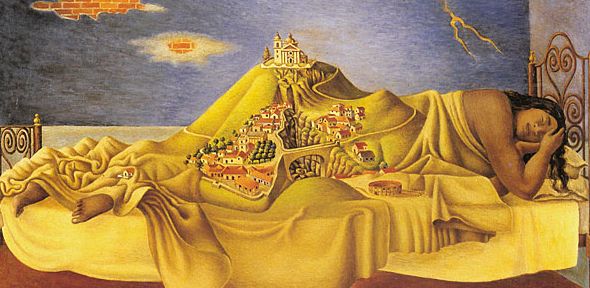
Antonio M. Ruiz, El sueño de la Malinche (1939)
This Reading List serves as an introductory guide to Sp7 and is organized as follows: I. Set primary texts for lectures, II. Set readings for seminars, and III. Recommended secondary readings for Sections A, B and C.
Lectures will revolve around the set primary texts, including critical readings and introductions to their historical and intellectual context. In addition to lectures, there will be one seminar-supervision each for Sections A and B. The set readings for seminars are select, required primary and secondary pieces. Seminar-supervisions will be focused on discussion, so students should prepare the indicated texts in advance. Recommended secondary readings are useful sources that will help consolidate and develop the material studied in the lectures.
Longer works, such as Don Quijote and the Comentarios reales de los Incas, should be read before term starts. Also, it would be very helpful to consult the Preparatory Reading list beforehand.
I. Set Primary Texts (and suggested editions)
Section A
- Amarilis, Epístola a Belardo, ed. M. Vinatea Recoba (Madrid/Frankfurt: Iberoamericana/Vervuert, 2009).
- Balbuena, Bernardo de, Grandeza mexicana, ed. A. Saad Maura (Madrid: Cátedra, 2011)
- “Clarinda”, Discurso en loor de la poesía, ed. A. Cornejo Polar (Lima: CELACP, 2009).
- Colón, Cristóbal, “Carta a Luis de Santángel”, in Textos y documentos completos, ed. Consuelo Varela and Juan Gil (Madrid: Alianza Editorial, 1992), 219-226.
- Fernández de Oviedo, Gonzalo, “Libro I”, “Libro VII – cap. XIV”, “Libro XII – cap. VII”, in Historia general y natural de las Indias, ed. Juan Pérez de Tudela Bueso (Madrid: Atlas, 1959), vol. 1: 7-12, 239-243; vol. 2: 32-35.
- Sahagún, Bernardino de, “Libro Primero”, in Historia general de las cosas de Nueva España, ed. A. Garibay (México City: Porrúa, 1956, 1981, 2013).
- Sahagún, Bernardino de, General History of the Things of New Spain: The Florentine Codex. [Manuscript] (Mexico, 1577). World Digital Library. The Library of Congress. https://www.wdl.org/en/item/10612/
- The Codex Mendoza, “La partida tercera, de esta historia”, in The Codex Mendoza, ed. F. Berdan and P. Rieff Anawalt (Berkeley: University of California Press, 1992), vol. 4: 118-148.
- The Codex Mendoza (México, c. 1540) [Manuscript], Instituto Nacional de Antropología e Historia. https://codicemendoza.inah.gob.mx/index.php?lang=english
- Vega, El Inca Garcilaso de la, Comentarios reales de los Incas, ed. Mercedes Serna (Madrid: Castalia, 2000).
Section B
- Calderón de la Barca, Pedro, La vida es sueño, ed. C. Morón (Madrid: Cátedra, 1977).
- Cruz, Sor Juana Inés de la, El divino Narciso, ed. R. A. Rice (Pamplona: EUNSA, 2005).
- Cruz, Sor Juana Inés de la, ‘Primero Sueño’, in Obras completas, I. Lírica personal, ed. A. Alatorre (Mexico City: FCE, 2012), 486-538.
- Góngora, Luis de, Soledades, ed. R. Jammes (Madrid: Castalia, 1994).
- León, Fray Luis de, ‘Qué descansada vida’ and ‘En vano el mar fatiga’, in Poesías completas, ed. C. Cuevas (Madrid: Castalia, 2001), 83-89, 103-105.
- Mañara, Miguel, Discurso de la verdad (Madrid: Alejandro Gómez Puentenebro, 1878).[Available online: http://archive.org/stream/discursodelaver00magoog#page/n13/mode/2up]
- Molina, Tirso de, Don Gil de las calzas verdes, ed. A. Zamora Vicente (Madrid: Castalia, 1990).
- Quevedo, Francisco de, La cuna y la sepultura; Doctrina moral, ed. C. C. García Valdés (Madrid: Cátedra, 2008).
- Quevedo, Francisco de, La vida del Buscón, ed. F. Cabo Aseguinolaza (Madrid: RAE, 2011).
- Vega, Lope de, Arte nuevo de hacer comedias, ed. E. García Santo-Tomás (Madrid: Cátedra, 2006).
- Vega, Lope de, El castigo sin venganza, ed. A. Carreño (Madrid: Cátedra, 2010).
Section C
- Cervantes, Miguel de, Don Quijote de la Mancha, ed. Instituto Cervantes, dir. F. Rico, 2 vols. (Madrid: RAE, 2015). [Or the same compact edition published by the RAE in 2005, or the edition by L. A. Murillo, El ingenioso hidalgo don Quijote de la Mancha, 2 vols. (Madrid: Castalia, 1978)]
II. Set Readings for Seminars
Section A
1. Cañizares-Esguerra, Jorge and Benjamin Breen, 'Hybrid Atlantics: Future Directions for the History of the Atlantic World', History Compass, 11/8 (2013): 597–609.
2. Russo, Alessandra, The Untranslatable Image: A Mestizo History of the Arts in New Spain (Austin: University of Texas Press, 2014) [selection].
Section B
Primary
-
Cruz, Sor Juana Inés de la, ‘Este, que ves, engaño colorido’, ‘En perseguirme, mundo, ¿qué interesas?’, in Obras completas, I. Lírica personal, ed. A. Alatorre (Mexico City: FCE, 2012), 387-89.
-
Góngora, Luis de, ‘Mientras por competir con tu cabello’, ‘¿Qué lleva el señor Esgueva?’, in Antología poética, ed. A. Carreira (Barcelona: Crítica, 2009), 96, 261-63.
-
Quevedo, Francisco de, ‘“¡Ah de la vida!”… ¿Nadie me responde?, ‘Érase un hombre a una nariz pegado’, in Heráclito cristiano, Canta sola a Lisi y otros poemas, eds. L. Schwartz and I. Arellano (Barcelona: Crítica, 1998), 5-6, 285-86.
-
Valle y Caviedes, Juan del, ‘Aprobaciones de este libro’, ‘Tasa’, ‘Fe de erratas’, ‘Licencia del ordinario de las damas’, ‘Privilegio’, ‘Tembló la tierra pesada’, in Guerras físicas, proezas medicales, hazañas de la ignorancia, ed. C. F. Cabanillas Cárdenas (Madrid/Frankfurt: Iberoamericana/Vervuert, 2013), 214-20, 277-78.
Secondary
-
Elliott, J. H., ‘Self-perception and Decline in Early Seventeenth-Century Spain’, in Spain and its World, 1500-1700 (New Haven/London: Yale UP, 1989), 241-61.
-
Robbins, Jeremy, ‘Triangles and Wheels, Telescopes and Flies: Gracián and the World of Wit’, in The Routledge Hispanic Studies Companion to Early Modern Spanish Literature and Culture, eds. R. Cacho Casal and C. Egan (London/New York: Routledge, 2022), 243-258.
III. Recommended Secondary Readings
Section A
Imperial Expansion as Knowledge
- Grafton, Anthony, “Introduction” and “All Coherence Gone”, in New Worlds, Ancient Texts. The Power of Tradition and the Shock of Discovery (Cambridge, MA: The Belknap Press of Harvard University Press, 1995), 1-10; 95-157.
- Pastor, Beatriz, “Chapter One: Christopher Columbus and the Definition of America as Booty,” in The Armature of Conquest: Spanish Accounts of the Discovery of America, 1492-1589 (Stanford: Stanford University Press, 1992), 9-49.
- Myers, Kathleen A., “Eyewitness to America’s Wonders: Illustrating a Natural History of the Indies”, in Fernández de Oviedo’s Chronicle of America. A New History of the World (Austin: University of Texas Press, 2007), 63-81.
The Circulation of Indigenous Knowledge
- Nicholson, H. B., “The History of the Codex Mendoza,” in The Codex Mendoza, ed. Frances F. Berdan and Patricia R. Anawalt, vol. 1 (Berkeley and Los Angeles: The University of California Press, 1992), 2-10.
- Bleichmar, Daniela, “Painting the Aztec Past in Early Colonial Mexico: Translation and Knowledge Production in the Codex Mendoza,” Renaissance Quarterly 72 (2019): 1362–415.
- Magaloni Kerpel, Diana, The Colors of the New World: Artists, Materials, and the Creation of the Florentine Codex (Los Angeles: Getty Research Institute, 2014), 1-59.
El Inca Garcilaso and the Mother Tongue
- Fernández, Christian, “Inca Garcilaso’s Biography,” in Inca Garcilaso and Contemporary World-Making, ed. Sara Castro-Klarén and Christian Fernández (Pittsburgh: University of Pittsburgh Press, 2016), 20-32.
- Zamora, Margarita, “Language and History in the Comentarios reales,” in Language, Authority, and Indigenous History in the ‘Comentarios reales de los Incas’ (Cambridge: CUP, 1988), 39-61.
- Zamora, Margarita, “’Mestizo...me lo llamo yo a boca llena y me honro con él,’ Race in Inca Garcilaso’s Royal Commentaries of the Incas and General History of Peru,” in Inca Garcilaso and Contemporary World-Making, ed. Sara Castro-Klarén and Christian Fernández (Pittsburgh: University of Pittsburgh Press, 2016), 174-194.
American Parnassus
- Cacho Casal, Rodrigo, ‘Balbuena’s Grandeza mexicana and the American Georgic’, Colonial Latin American Review 24.2 (2015), 190-214.
- Fuchs, Barbara, and Martínez-San Miguel, Yolanda, ‘La Grandeza mexicana de Balbuena y el imaginario de una “metrópolis colonial”’, Revista Iberoamericana 75 (2009), 675-95.
- Chang-Rodríguez, Raquel, ‘Clarinda, Amarilis y la ‘fruta nueva’ del Parnaso peruano’, Colonial Latin American Review 4.2 (1995), 181-96.
Section B
The Baroque Mind
- Maravall, José Antonio, La cultura del Barroco (Barcelona: Ariel, 1980), Introduction, chapters 2 and 6 [23-51, 131-75, 309-55].
- Robbins, Jeremy, Arts of Perception: The Epistemological Mentality of the Spanish Baroque, 1580-1720 (New York: Routledge, 2007), Introduction, chapters 1-2 [1-63].
- Egido, Aurora, ‘La hidra bocal. Sobre la palabra poética en el Barroco’, in Fronteras de la poesía en el Barroco (Barcelona: Crítica, 1990), 9-55.
Hybrid Drama
- Arellano, Ignacio, ‘Convenciones y rasgos genéricos en la comedia de capa y espada’, Cuadernos de Teatro Clásico 1 (1988), 27-49.
- Kluge, Sofie, ‘A Hermaphrodite? Lope de Vega and the Controversy of Tragicomedy’, Comparative Drama, 41 (2007), 297-335.
- Thacker, Jonathan, Role-Play and the World as Stage in the ‘comedia’ (Liverpool: Liverpool UP, 2002), Introduction [1-18].
Góngora and the Atlantic World
- Carreria, Antonio, ‘La novedad de las Soledades’, in Gongoremas (Barcelona: Península, 1998), 225-37.
- Roses Lozano, Joaquín, Una poética de la oscuridad: la recepción crítica de las ‘Soledades’ en el siglo XVII (Madrid/London: Tamesis, 1994), chapters 2 and 4 [66-80, 102-51].
- Ruth Hill, Sceptres and Sciences in the Spains: Four Humanists and the New Philosophy (ca. 1680-1740) (Liverpool: Liverpool UP, 2000), ‘Christian Epicureanism and the Imitation of the Natural Philosopher’s Task’ [49-70].
The Baroque Turn and the Visual Arts
- Gombrich, E. H., The Story of Art (London/New York: Phaidon, 1995), Introduction, chapter 19 [15-37, 387-411].
- Welles, Marcia L., ‘Velázquez: His Mythological Paintings’, Arachne’s Tapestry: The Transformation of Myth in Seventeenth-Century Spain (San Antonio, Texas: Trinity UP, 1986), 131-65.
- Brown, Jonathan, ‘Hieroglyphs of Death and Salvation: The Decoration of the Church of the Hermandad de la Caridad, Seville’, Art Bulletin 52.3 (1970), 265-77.
- Knox, Giles, The Late Paintings of Velazquez (London and New York: Ashgate/Routledge, 2016)
- Portús, Javier, ed., Fábulas de Velazquez: mitologia e historia sagrada en el Siglo de Oro (Madrid: Museo Nacional de el Prado, 2007)
- Portús, Javier, Metapintura: un viaje a la idea del arte en España (Madrid: Museo Nacional del Prado, 2016)
Section C
- Close, Anthony, ‘Don Quixote and the Modern Novel’, in A Companion to ‘Don Quixote’ (Woodbridge: Tamesis, 2008), 227-53.
- Garcés, María Antonia, Cervantes in Algiers: a Captive’s Tale (Nashville: Vanderbilt UP, 2002), Introduction and chapter 4 [1-14, 182-232].
- Haley, George, “The Narrator in Don Quijote: Maese Pedro’s Puppet Show”, MLN 80 (1965), 145-65.
- Redondo, Augustin, ‘Acercamiento al Quijote desde una perspectiva histórico-social’, in Otra manera de leer el ‘Quijote’ (Madrid: Castalia, 1997), 55-99.
- Riley, E. C., Cervantes’s Theory of the Novel (Oxford: OUP, 1962), chapter 5 [163-99].
- Russell, P. E., ‘Don Quixote as a Funny Book’, MLN 64 (1969), 312-26.



